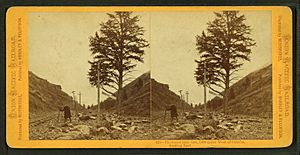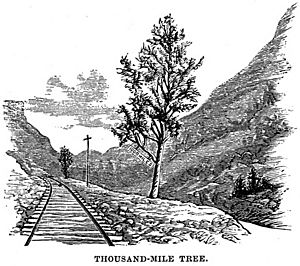Thousand Mile Tree facts for kids

The Thousand Mile Tree is a special pine tree located in Weber Canyon, near Henefer, Utah. It stands along the Overland Route of the Union Pacific Railroad. This tree is famous because it marked a very important spot on the First transcontinental railroad.
In January 1869, workers building the railroad found a tree that happened to be exactly one thousand miles from Omaha, Nebraska/Council Bluffs, Iowa. These cities were the starting point of the railroad in the east. This discovery made the tree an instant landmark.
A Special Landmark Tree
The original Thousand Mile Tree stood next to the Weber River. This area is known as Wilhelmina's Pass. It was about 5,257 feet (1,602 meters) above sea level.
Discovering the Original Tree
About a week after January 15, 1869, the railroad tracks reached this tall tree. It was about 90 feet (27 meters) high. Because it was exactly 1,000 miles from Omaha, a sign was quickly hung on it. This sign clearly showed its special distance.
The tree was in a deep gorge between Henefer and Devil’s Slide. Devil's Slide is a unique rock formation with two limestone ridges. Both the Thousand Mile Tree and Devil's Slide became popular sights. Many early trains would stop so passengers could admire these landmarks.
The Tree's Story Through Time
By the year 1900, the original Thousand Mile Tree had sadly died. It was removed in September of that year. Later, changes to the railroad line meant the distance to that spot was no longer exactly 1,000 miles. It became about 959.66 miles (1,544.47 kilometers).
In 1982, the Union Pacific Railroad planted a new tree to remember the spot. This replacement tree stands there today inside a special fenced area. It has grown to be over 30 feet (9 meters) tall. It continues the legacy of the original Thousand Mile Tree.


